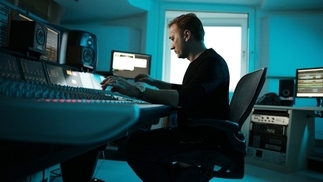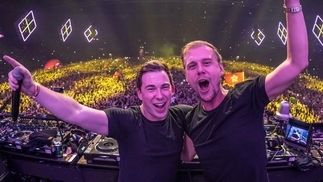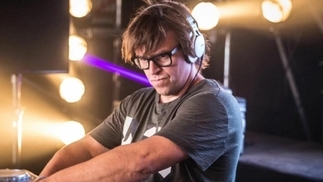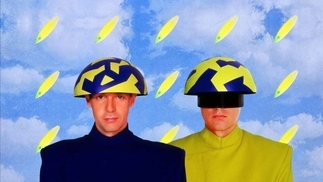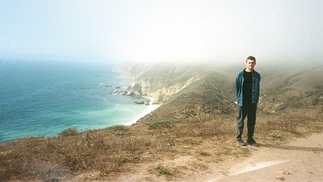LANGE: LIVING LUCKY
UK producer Lange delivers an exquisite selection of melodic trance
"We are the music makers, and we are the dreamers of dreams." It's these resonating words — spoken by Willy Wonka in the original film adaptation of Roald Dahl's Charlie and the Chocolate Factory — that open Lange's new artist album, 'We Are Lucky People'. Layered over sweeping symphonic arpeggios, this introduction sets the tone for the rest of the album — an expansive double-feature, with a set of masterfully crafted singles and an accompanying disc of reworked club mixes.
The third artist album from Brit producer Lange, AKA Stuart Langelaan, it's also the most involved production the veteran producer has taken on. Featuring a myriad of collaborations, reworks, and original tracks, the album began gaining momentum months ago when Lange started releasing singles in a build-up to its release this month.
Making waves across the digital scene, individual releases such as galloping piano anthem 'Destination Anywhere', flew into the Beatport charts and beyond, infiltrating podcasts and DJ sets of artists around the globe.
We catch up with Lange on the cusp of the album's release to learn some of the story behind his sound. From his development as an artist to his thoughts on the current state of trance, Lange openly details the life of a trance kingpin. If one thing is certain, it's that his music is all the assurance we need to know that we all are, indeed, lucky people.
We Are Lucky People marks your third artist album. What does the album title mean to you?
“The title came to me on a flight. I was thinking about how lucky myself and other DJs are to be traveling the world every weekend, meeting new people and having some amazing experiences. As always, I added the idea to my iPhone's 'title ideas' list, and then a few weeks later I wrote the single of the same name. This was quite a key point for me towards the end of last year, as I'd had a pretty uninspiring year in the studio and I felt I'd found a new path to take. I was getting bored of focusing too much on the 'drop' moment in tracks and wanted to return to focusing on emotive melodies, to make some music with substance. It had been three years since finishing my 'Harmonic Motion' album — which is long enough to forget the trauma writing an album can cause — and I was ready to take on album No.3. The title has taken on a much wider meaning for me since that flight. I think many of us are a lot luckier than we give credit for and take too much for granted.”
How do you feel you've progressed as an artist through each album's milestone?
“You can't know everything about music, it's a continuous learning experience. With each album I've felt more educated, but that's not to say music is always better as a result of experience. Some of the most effective music, particularly in the dance arena, is often the simplest. What I do feel with this one is that I've achieved a better overall album, in that I focused my efforts into making it something that flows from start to finish and feels complete. This album definitely feels the most special and although it's been the hardest to do, it was the easiest and most inspiring to write. The difficulty this time came from this being my busiest year touring-wise, and me expanding my radio show to a weekly format. It's literally been non-stop work every day this year.”
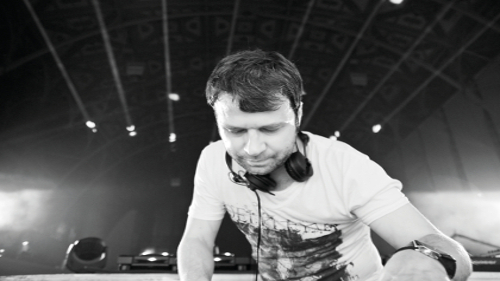
You've been on the scene for over 15 years now. What are the biggest changes to the industry and the music that you've seen over the length of your career?
“A lot has happened in those 15 years, the biggest changes being to music production and marketing. When I started, I had a relatively basic home studio. Bearing in mind, I'd not long finished university and didn't have a proper job at that point; getting the gear together itself was quite an achievement. I was using an Atari ST running Cubase and hardware I'd gradually bought as I could afford it (thanks Student Loans company). So everything took longer, you had to save all the data from each synth and effect, and even write down all the mixer settings in case you needed to revisit a track. Now it's a simple case of pressing Ctrl S on your Mac.
“Also, everything was so expensive, I recall upgrading my Akai sampler, adding an extra 1.5MB of memory for a whopping £350! Creativity-wise, improvements with software have meant there are few limits on what's achievable in the studio now — although I have to say sometimes having so much choice can be a problem in itself. The arrival of the internet connected us to a whole world of dance music lovers, but resulted in a massive drop in sales due to piracy. The major labels were far too slow to make music available digitally and so a generation pretty much got used to music being something you grab for free. As a result, DJing and live performance has now become the main income for artists in EDM.
I guess that's the reason so many DJs have outsourced much of the production work — the most challenging work — to ghost writers. The problem is, this results in a lot of artists sounding the same!
“Trance music itself has changed a lot in this time too. Generally BPMs have come down and it's not all about the saw riffs of the late '90s.
There are some that hark back to those years as the days of real trance, but the reality is trance started way before the UK trance peak of 1998-2000, and some 'purists' were arguing at that time that music by the likes of Ferry Corsten, Matt Darey, and myself wasn't 'real trance.' For some time many trance artists have been open to other influences, blending those euphoric melodies and vocals with electro, techno, and more recently the big room sound. Actually, with the recent EDM explosion in the USA, it seems like house music took elements from trance to create a more epic big room sound. I mean, to me, Swedish House Mafia's 'One' has trance written all over it. Ultimately trance has always been about a certain feeling the music gives you, and a certain crowd of people obsessed with the euphoria and passion the music gives them, rather than how they look, or trying to impress with the bottle service bullshit that's plaguing much of the USA EDM scene right now.”
You've collaborated with some phenomenal vocalists, not only in 'We Are Lucky People' but also in your past work. What is the process like in working with different vocalists and how involved are you in the lyrical process?
“I nearly always write the music around an acapella sent by a writer/vocalist. I've always worked better this way and feel the vocals really sit better in the track when the music wraps around them. When I started out, I did a lot of remix work so I think perhaps that kind of background got me used to working with vocals in place at the start. Often a track will start with me sending an instrumental to a vocalist for inspiration, but usually I then take the vocal and find alternative chords to work with it, so the resulting track is completely different. I've been involved in minor lyric changes a few times, but generally I don't write the lyrics.”
Rewinding a bit, how did you get your start producing? How have you evolved as a DJ in relation to your own productions?
“When I was at college doing A Levels I realized I wanted to produce, and by the time I'd finished uni I had a low budget studio set-up. I actually got my break after sending demos to Future Music magazine, which attracted some label A&Rs. Once I made that connection I signed to Additive records (sister label of Positiva.) They gave me my first remix work and I ended up having a few remixes hit the UK charts, including 'Protect Your Mind' (No.4) and 'Happiness Happening' (No.18.) At this stage my studio was still in my bedroom and was very basic — I mean some of my effects units were cheap guitar units and I had a cheap analog mixing desk! This catapulted me into the scene and I became a pretty in-demand remixer at that time... I recall having dozens of remixes queued up at one point!
I then went on to have a few chart hits of my own with 'You Take My Breath Away' and 'Drifting Away'. I started DJing around 2000, getting thrown into the deep end a bit playing clubs like Passion. This was in the days of vinyl, of course, and to be honest I wasn't quite ready to go from budding studio producer to headline DJ, so it was a bit of a shaky start. I've certainly learnt a lot about DJing since! Throughout my DJ career I've battled with styles. I love playing harder stuff with strong grooves, even some more techno-edged tracks, but production-wise I'm very much about the melodies. Experience has given me the confidence to do a bit of everything these days — ultimately you must produce and play the music you want to, you have to be true to yourself, and I've always got bored if I do the same thing for too long. So I go through phases in the studio where I'll aim to produce the darker club bangers one month, and the melodic, ethereal stuff another. Personally it keeps me sane, but no doubt I'm probably confusing my fan base a bit!”
How has your perception of your own music changed over time?
“I don't think it's easy to analyze your own music style. People have referred to a 'Lange sound' before, but I've never really known what that is. I've thrown some curveballs out there, so feel my spectrum is pretty wide, but maybe there's something that links it all together? I think the quality of my music has improved over the years, but I hear it time and time again from the more old school fans that my best track was 'Follow Me' or 'Happiness Happening' from the 'golden era.' Maybe they're right, or maybe they're getting wrapped up in the power of nostalgia? Either way, there are highlights throughout the whole time frame that I'm proud of (and a few I’m less so!).”
What are the most notable differences between the trance scene in the UK versus the US? Do you feel as strong a connection to the scene in the States?
“The UK seems to have quite a polarised view on what trance is. Ask clubbers north of London and they say it's got to be at least 138bpm with a rolling bassline. I've played clubs in the north where a resident DJ before me has typically said, 'you'll need to keep it up at 140 mate'. Well, I'm sneaky and I've managed on many of those occasions to creep the BPM down to 132 with no apparent loss of energy or reactions. BPM isn't the key factor — it's actually an easy way to give a track more energy, but groove just disappears at those speeds so I prefer to produce between 130-134.
Stateside there are far less preconceptions about what trance should be, but that probably is because they didn't go through what we did in the UK back in 1998-2000. But, now that EDM has erupted in the USA, it seems trance may be getting a bit lost over there amongst all the big room drops. Play after any DJ smashing it out with the most epic of quick mixed EDM slammers and you'll be hard pushed to get the crowd's attention with anything particularly emotive or melodic without a cunning set progression (I always revel in the challenge). I'm happy slamming it out with the more inventive tracks out there, but there's a lot of the same old same old; it's become generic.
Move away from the totally commercially poised clubs and there are still a vast number of great events out there, mostly run by promoters who still feel passionate about the music. When this current EDM peak slows, it'll be the commercial clubs who revert back to hip-hop or whatever, and those holding true to the music will still be there. In fact, I really feel that trance, as well as other more underground genres, are set to make a big comeback. The clubbers are getting bored of being spoon-fed the same Top 20 tracks from Beatport from the same hyper-marketed money-making machines, even if they do get free cake and champagne all over them. This has turned into a right rant, but I think it's time to stop punching the air and let your feet do the talking.”
Trance is a genre that is typically associated with unity and acceptance, yet when artists divert from the “classic” sound there can be a lot of backlash from fans. What do you attribute that to and what do you see for the future of the genre?
“I have to say I hate the haters hating and feel this kind of attack on artists is ridiculous! Music needs to progress, and artists need to diversify their sound to prevent boredom, if not insanity! Many years back I used to worry if I might be stepping out of my genre. Now I don't even think twice. But some seem to get a lot of flack for doing just that. I recall Orjan Nilsen mentioning this before and one point he made was that people are un-accepting of him being experimental now and are pointing at his earlier work as 'classics.' Yet at the time he made those 'classics,' he also received a backlash about them being different! I think the reason trance fans are more notorious for this response is because they're generally very passionate about their scene, don't want to 'lose' their favorite artists, and have always been more active online.”
You celebrated the 100th episode of your Intercity radio show with an incredible 24-hour worldwide broadcast. What went into creating the concept and how did you go about selecting the artists involved?
“Yeah, that show was a big success, I think we ended up with some 20,000 tweets using the hashtag and it trended globally on Twitter. The idea for Intercity 100 was to choose a selection of artists from all around the world, scheduling their set times so they'd be playing peak time in their own country. I'm celebrating Intercity 150 in a week's time and I'm doing another 24 hour takeover of Afterhours FM. Again, this year's artists include some of the biggest names in trance, including Paul van Dyk, Paul Oakenfold, Ferry Corsten, and Markus Schulz.”
How crucial do you think the presence of podcasts and radio shows is in today's technology-driven music scene?
“Probably less crucial now as the scene is over-saturated with them, but it's a great way to reach out to your followers, not only the ones who come to club shows but also those who maybe don't get to see your sets very often due to their location.”
Owning your own label, you must be constantly exposed to new music. What emerging styles and sounds do you see as the most promising? How do you deal with the nonstop influx of music?
“It's difficult to say right now, as much of what we get sent is stuff chasing the current commercial trends. I've picked up on a few breaks-infused trancers of late, that could be interesting. I fortunately have assistance in dealing with the vast quantities of demos we receive. I'm still head of A&R at Lange Recordings, I can't let go of that role, and I try to be as involved with the artists who sign to us as possible.”
Where do you see the scene, and yourself, in three years?
“I expect the EDM scene in the USA will have definitely come back down to earth by then. Maybe an emerging country like India will be the next EDM hotspot! As I mentioned before, I'd like to think there will be a move by clubbers to support the more underground venues, and that the trance scene will have benefitted from this. Me? I'll probably have forgotten just how difficult this latest album was to write and I'll be considering making my fourth! Please can someone remind me not to do it in 2016?”
